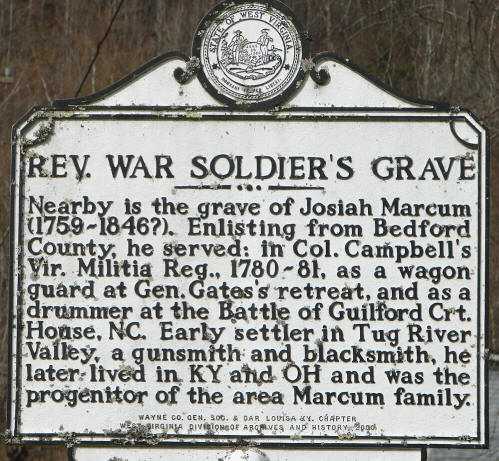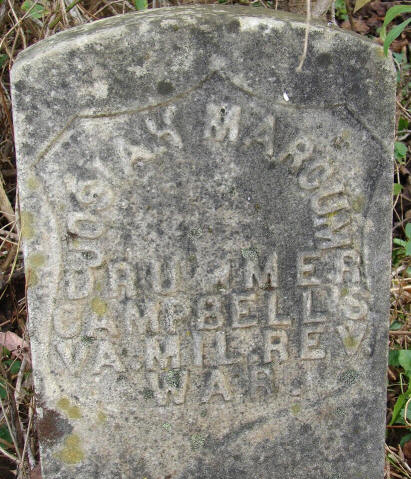
JOSIAH MARCUM

-------------------------------------------------------------------------------------------

-------------------------------------------------------------------------------------------
This solitary grave is located in a bottom
near Jennie’s Creek surrounded by quiet hills. It is one of the few marked
Revolutionary War Soldier’s graves in the Tug Valley.
The simple inscription on the rough gray stone
tells little about this man who lived during the founding years of our nation.
However, there is available from the past a most interesting document which
tells much about Josiah Marcum, the frontier colonial soldier of the American
Revolution.
On Nov 2, 1832, nearly 175 years ago, when Andrew Jackson was the seventh
president of the new nation, Josiah Marcum, then a man 73 years old, appeared in
person before the circuit court judge at Louisa, Lawrence County, Kentucky and
applied for a soldier’s pension.
His statements plus the supporting evidence of two witnesses supplement the
meager scraps of information found on the gravestone.
They also offer strong reminders of the stirring events and the treachery
and intrigue which marked the beginnings of the United States of America.
A review of American history supplies even more needed materials in the way
of facts and dates to fill in the interesting account as related by this man who
was born almost 250 years ago, when the American colonies were still under the
rule of the British Crown.
First, Josiah Marcum stated that he had been told by his parents that he was
born May 2, 1759, in Chesterfield County, Va., along the James River although he
had no written evidence to prove the date.
He continued that when but a child of four or five years, he moved to Prince
Edward County. While Josiah was yet a boy, the family moved further westward to
Bedford County where he grew to manhood and volunteered for service in the
Virginia Militia as an “18 months” soldier.
From Bedford, where he was enlisted, he was marched into North Carolina and
was in Gates’ Defeat “only a short time” after he entered the service.
He was a waggoner as well as a drummer and he explained that it was his duty
to drive a baggage wagon filled with supplies to the vicinity of the battle.
In his pension application, Josiah Marcum could not establish dates for any
of these happenings. But he knew, and stated repeatedly for emphasis that he
volunteered “in the spring immediately preceding the defeat of General Gates.”
That one statement speaks volumes to the American who cares to turn back the
pages of history to an account of the Revolution War years.
“Gates Defeat” at Camden, S. C. on Aug. 17, 1780, has been likened to “the
darkest hour before the dawn”, in the winning of the Revolution. Lord Cornwallis
demolished the American Army under General Gates. The Americans lost over 2,000
men while the British losses amounted to 734.
From his testimony, Josiah never forgot that retreat from Camden nor General
Gates either.
On Nov. 7, 1833, David Adkins, another Revolutionary War veteran, stated
that he saw Josiah Marcum at Hillsbourgh in North Carolina in the American
Army.”
The first time he saw him, a part of the army was being marched out to a
place where one of the soldiers was to be whipped. Adkins and Marcum led the
procession with fife and drum.
Adkins further declared that he saw Josiah Marcum beating the drum in one of
the companies stationed at Hillsborough just before the defeat of General Gates.
Adkins as fifer, and Marcum with the drum were marched out with a portion of
the army together. But after they left Hillsborough, Adkins did not see him
again “to his recollection.”
Marcum stated that after the defeat of Gates he was marched back to
Hillsborough where headquarters were located for a portion of the army.
He spent the winter there and on scouting parties all the while continuing
to drive the baggage wagon and to beat the drum.
During this time he was in Campbell’s regiment under General Stephens who
was in charge of the “18 months” men.
Then, history tells that out of the defeat came victory. The American
victory of King’s Mountain came in October, 1780. By December of the same year
General Nathaniel Greene whose loyalty never was questioned, was sent to replace
Gates who was retired permanently in disgrace.
Then followed the Battle of Cowpens on Jan. 17, 1781 and the “Campaign of
the Rivers” in which General Greene played hide-and-seek with the Red Coats
along the headwaters of five flooded rivers up and down the Carolinas.
By March 15, 1781, when Cornwallis attacked the Frontier Army at Guilford
Courthouse, Greene held the line at Guilford after the British had chased the
frontiersmen all the way across North Carolina.
According to his pension declaration, Josiah Marcum held the line right
along with Greene after driving the baggage wagon along the back hill country.
By April of 1781, Cornwallis had moved north to Virginia and tried to
Capture Governor Jefferson on the way. The last strategies of war were to bring
about his historic surrender of Yorktown on Oct. 19, 1781.
Josiah Marcum could not recall the date but he knew when the war was over.
His 18 months of service was completed and he was discharged at Hillsborough
Courthouse “in the fall of the year.”
He well remembered that on his way home to Virginia, the fruit in the
orchards was ripe and “many people refused to let the soldiers have any.”
The remaining evidence in the pension declaration tells more of the
happenings of later life in the life of Josiah Marcum.
In Nov. 7, 1833, his son Stephen Marcum, then 48 years old, stated that he
had seen the discharge which his father received when he left the Revolutionary
War.
It had been “almost 35 years ago” and he remembered well that the discharge
stated that his father had served the enlistment of 18 months.
Stephen, with another individual, examined the papers of his father looking
for the bill of sale of a Negro woman and found the discharge: and “they had
some conversation in relation to the Revolutionary War and the old man talked of
other times and told many anecdotes of things which happened whilst he was a
soldier.”
Adding another very human touch to the record, Josiah Marcum stated that his
discharged was signed by Captain Tate but “he had it washed up in his pockets
about 20 or 25 years ago.”
He repeated that he had no documentary evidence but gave the names of three
other veterans -- Silas Wooten, Edward Burgess, and David Adkins -- who knew of
his having been in the service.
His last statement was that the regiment to which he had attached was
commanded by Colonel Campbell.
“Campbell’s Regiment” is well known in Virginia history. Robert Campbell was
a famous Indian fighter before Governor Jefferson gave him a Colonel’s
Commission and authorized the formation of additional units to be attached to
the brigade of General William Campbell.
Many of these men who served also surveyed lands in Western Virginia. Josiah
Marcum was one of the few who settled in person and for many years had extensive
land holdings on both sides of Tug River in both Lawrence County in Kentucky and
Cabell (later Wayne) on the Virginia side.
That Josiah Marcum passed from this life on March of 1846 a few weeks
before his 87th birthday.
[ Back ]